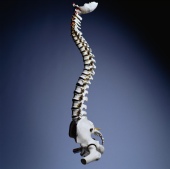
TUESDAY, Nov. 15 (HealthDay News) — A novel treatment known as whole-body vibration doesn’t appear to improve the bone health of postmenopausal women who are at high risk of developing osteoporosis.
The treatment — which involves standing on a motorized, vibrating platform in the hope of building bone mass — showed promise in animals. But researchers, who hoped those results might translate to humans, found no benefit for women who used the platforms for a year, said study co-author Angela M. Cheung, an internist and director of the osteoporosis program at the University Health Network, University of Toronto.
“People should use strategies that have been proven” to prevent bone loss and osteoporosis, Cheung said. These include exercise and calcium and vitamin D supplements, she said. The vibrating platform “doesn’t do anything, not for bone anyway,” she added.
The theory behind whole-body vibration is that the gravitational force sends signals to bone cells that promote regrowth, leading to better bone health. Bone deterioration is of special concern to aging women, half of whom may sustain fractures because bone mass deteriorates rapidly after menopause, according to the U.S. National Library of Medicine.
Vibration platforms, which cost about $3,000, have grown in popularity in recent years. Some health food stores and gyms make them available to patrons, Cheung said.
In the new study, published in the Nov. 15 issue of Annals of Internal Medicine, researchers randomly assigned about 200 postmenopausal women to one of three groups. Two groups used a low-magnitude, whole-body vibration platform at one of two speeds for a year, standing on it for 20 minutes a day. The third group did nothing out of the ordinary.
All the women had low bone mass, and all took calcium and vitamin D supplements. “We wanted to see if (the treatment) prevented bone loss or could increase bone mass,” Cheung said.
After a year, there was no difference in rate of bone loss among the three groups, the researchers said.
However, Cheung cautioned that it’s still unclear whether the treatment might affect bone in other groups of people, such as children.
Dr. Joseph Lane, professor of orthopedic surgery at Weill Medical College of Cornell University, said the study appears valid and debunks the use of whole-body therapy to treat bone loss. Currently, he said, bisphosphonate medications such as Fosamax are the best initial treatment for bone loss, while teriparatide (Forteo) is an alternative for patients who suffer from side effects on bisphosphonates.
Patients with osteoporosis are also beginning to take denosumab (Prolia), an injectable drug approved last year by the U.S. Food and Drug Administration.
More information
For more on osteoporosis, visit the U.S. National Library of Medicine.

